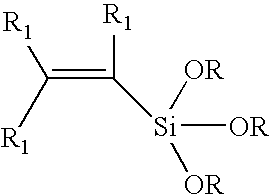Process for copolymerizing ethylene with vinylsilanes
a technology of vinylsilane and ethylene, which is applied in the field of making ethylene copolymers, can solve the problems of reducing the flexibility of making a variety of polymers, reducing the efficiency of catalysts, and reducing the efficiency of polyolefin chains
- Summary
- Abstract
- Description
- Claims
- Application Information
AI Technical Summary
Problems solved by technology
Method used
Image
Examples
example 1
Copolymerization of Ethylene and Vinyltriethoxysilane
[0024]A 20 mL steel vessel equipped with a 15 mL glass liner is charged with 5.0 mL heptane, 0.2 mL of a mineral oil slurry of catalyst A (approximate titanium content=1.3×10−5 g Ti), 0.1 mL of a solution of 1.56 M triethyl aluminum in heptane, and 0.1 mL of 0.47 M vinyltriethoxysilane (VTEOS) in heptane (47 micromoles vinyltriethoxysilane). The vessel is heated to 80° C. Hydrogen is added to pressurize the vessel to 0.07 MPa and ethylene fed to the vessel to maintain 1.4 MPa. The polymerization proceeds for thirty minutes. The reactor is vented and methanol added. The solvent is evaporated and the polyolefin is collected and dried prior to testing. The reaction yields 0.33 g polyolefin. The weight average (Mw) molecular weight and number average (Mn) molecular weight of the polymer are measured by gel permeation chromatography (GPC) using 1,3,5-trichlorobenzene at 145° C. to be 1.2×106 g / mole and 1.2×105 g / mole. The melting point...
PUM
| Property | Measurement | Unit |
|---|---|---|
| temperature | aaaaa | aaaaa |
| pressure | aaaaa | aaaaa |
| pressures | aaaaa | aaaaa |
Abstract
Description
Claims
Application Information
 Login to View More
Login to View More - R&D
- Intellectual Property
- Life Sciences
- Materials
- Tech Scout
- Unparalleled Data Quality
- Higher Quality Content
- 60% Fewer Hallucinations
Browse by: Latest US Patents, China's latest patents, Technical Efficacy Thesaurus, Application Domain, Technology Topic, Popular Technical Reports.
© 2025 PatSnap. All rights reserved.Legal|Privacy policy|Modern Slavery Act Transparency Statement|Sitemap|About US| Contact US: help@patsnap.com


